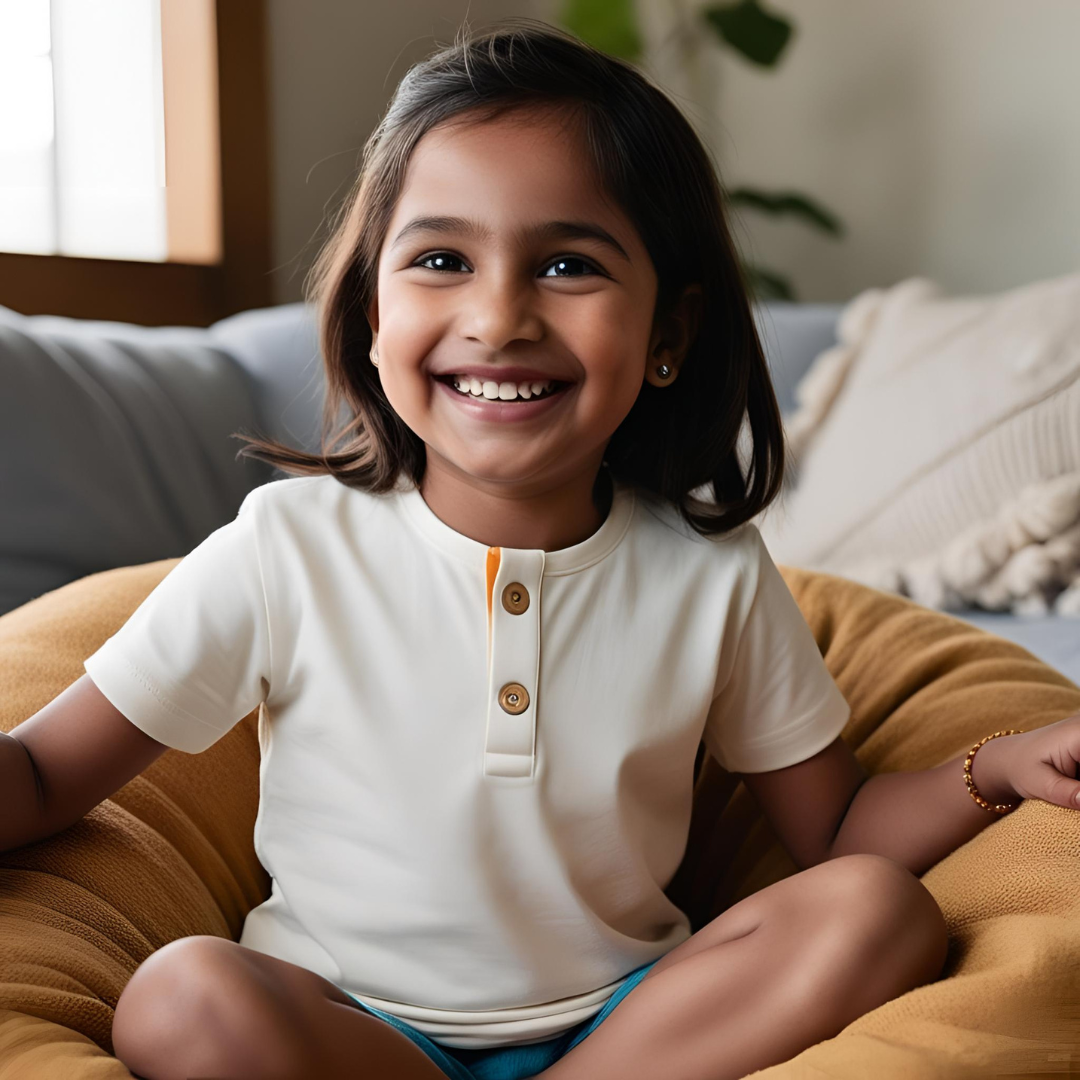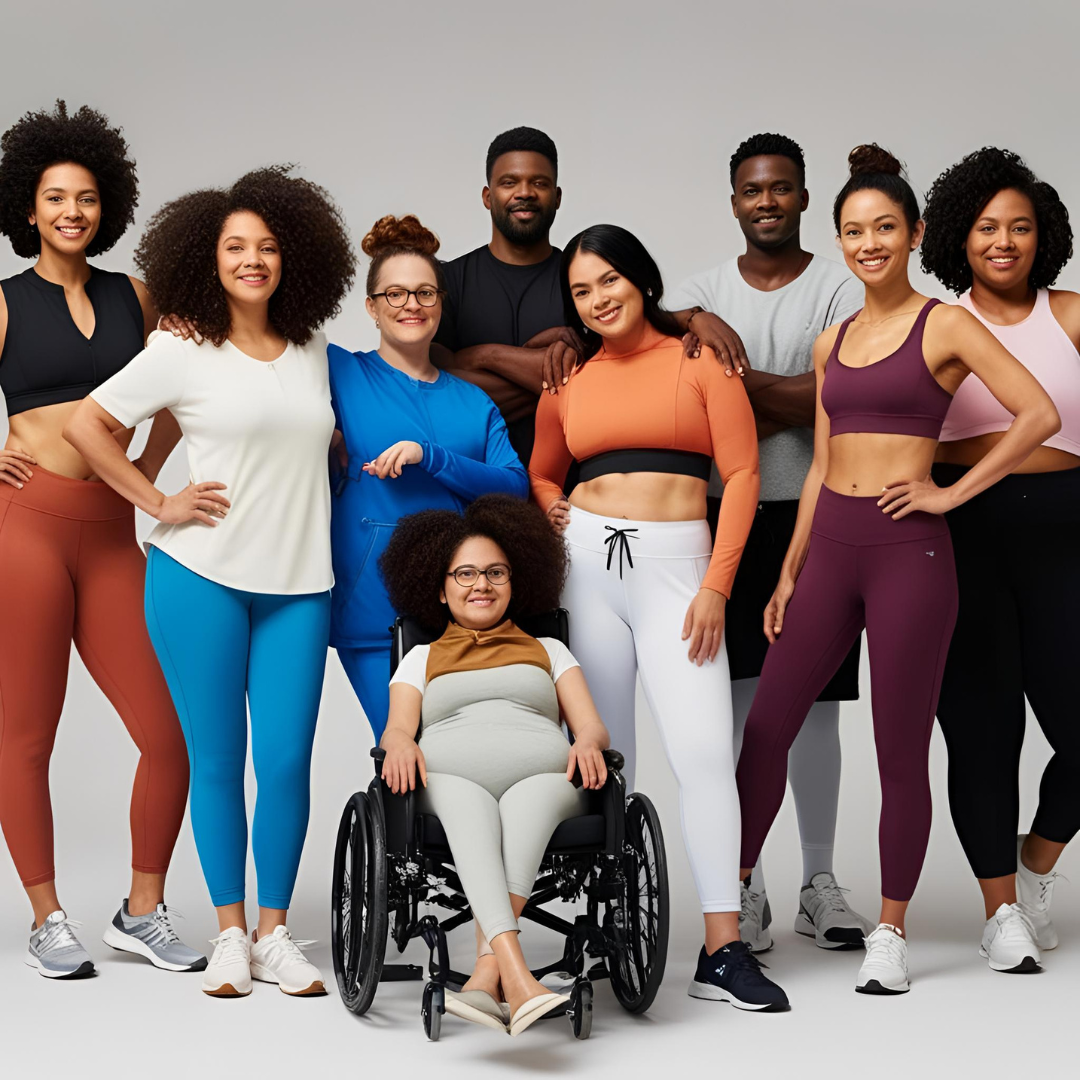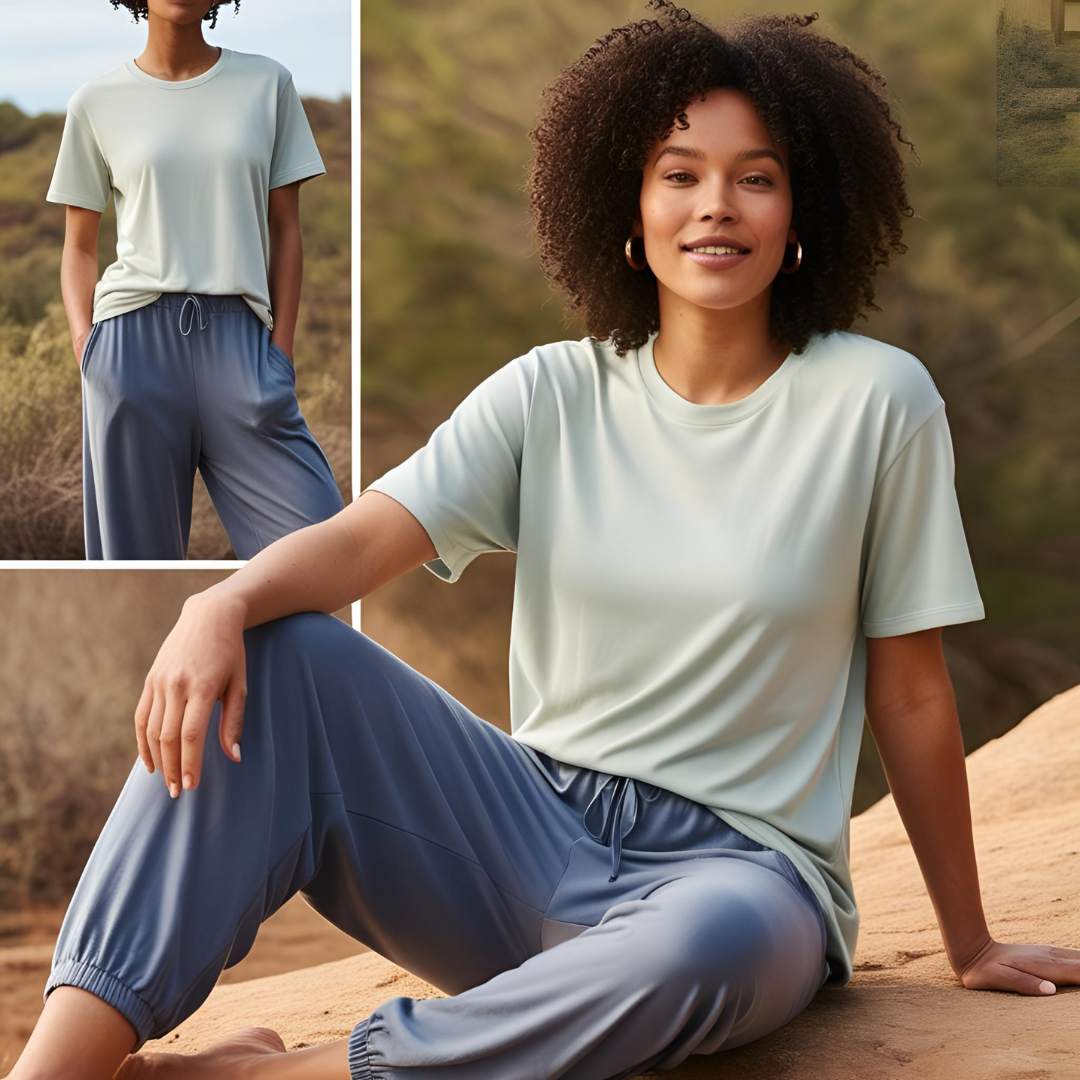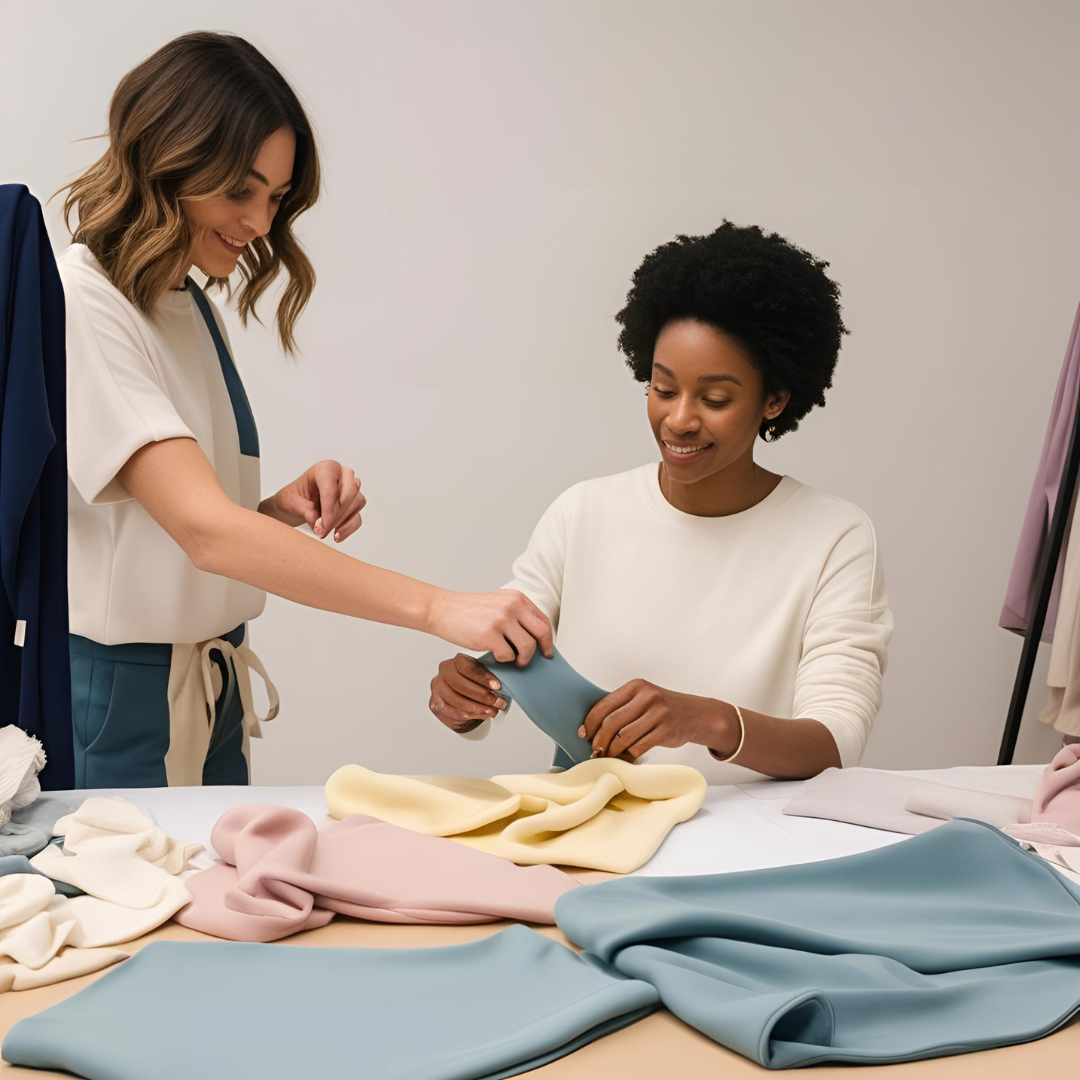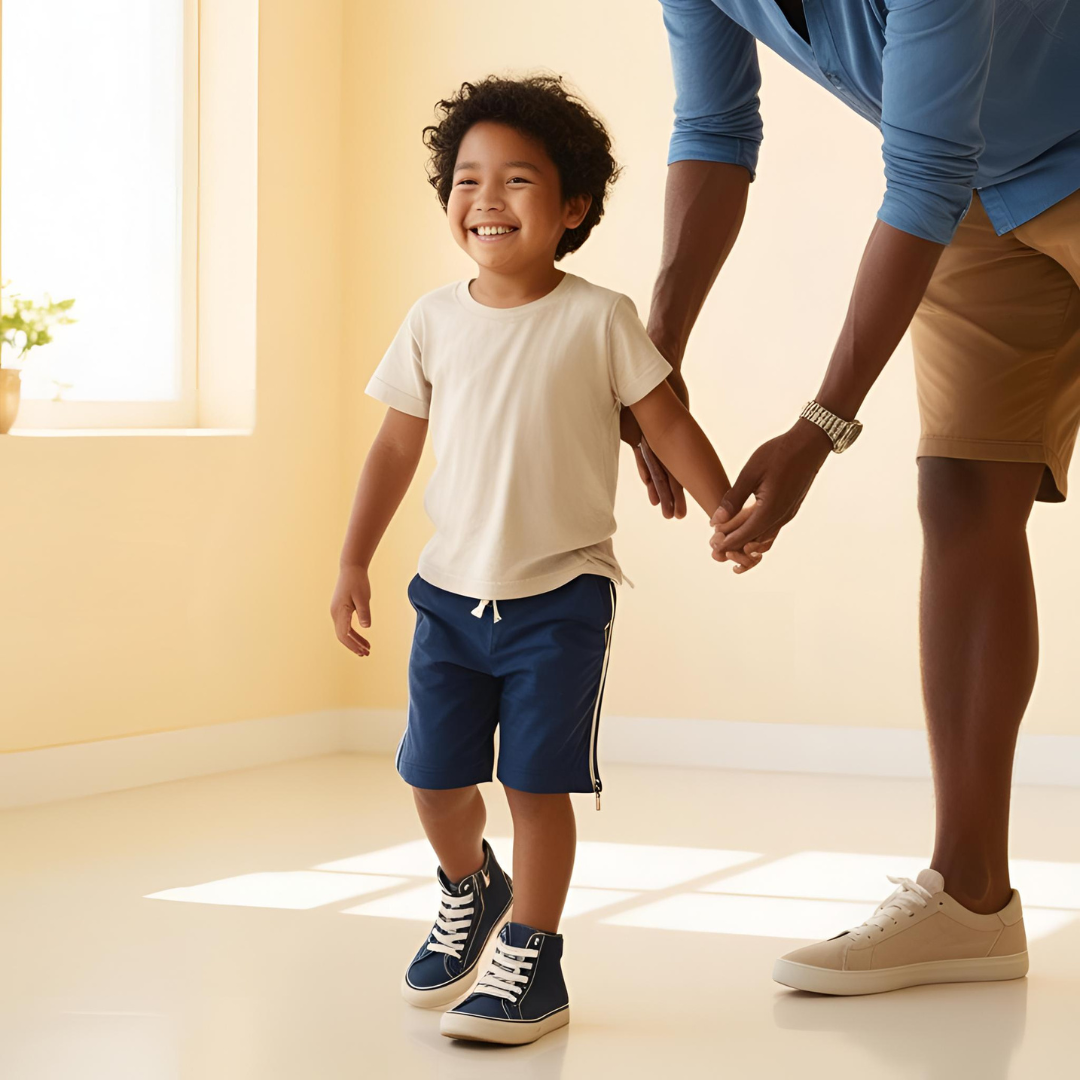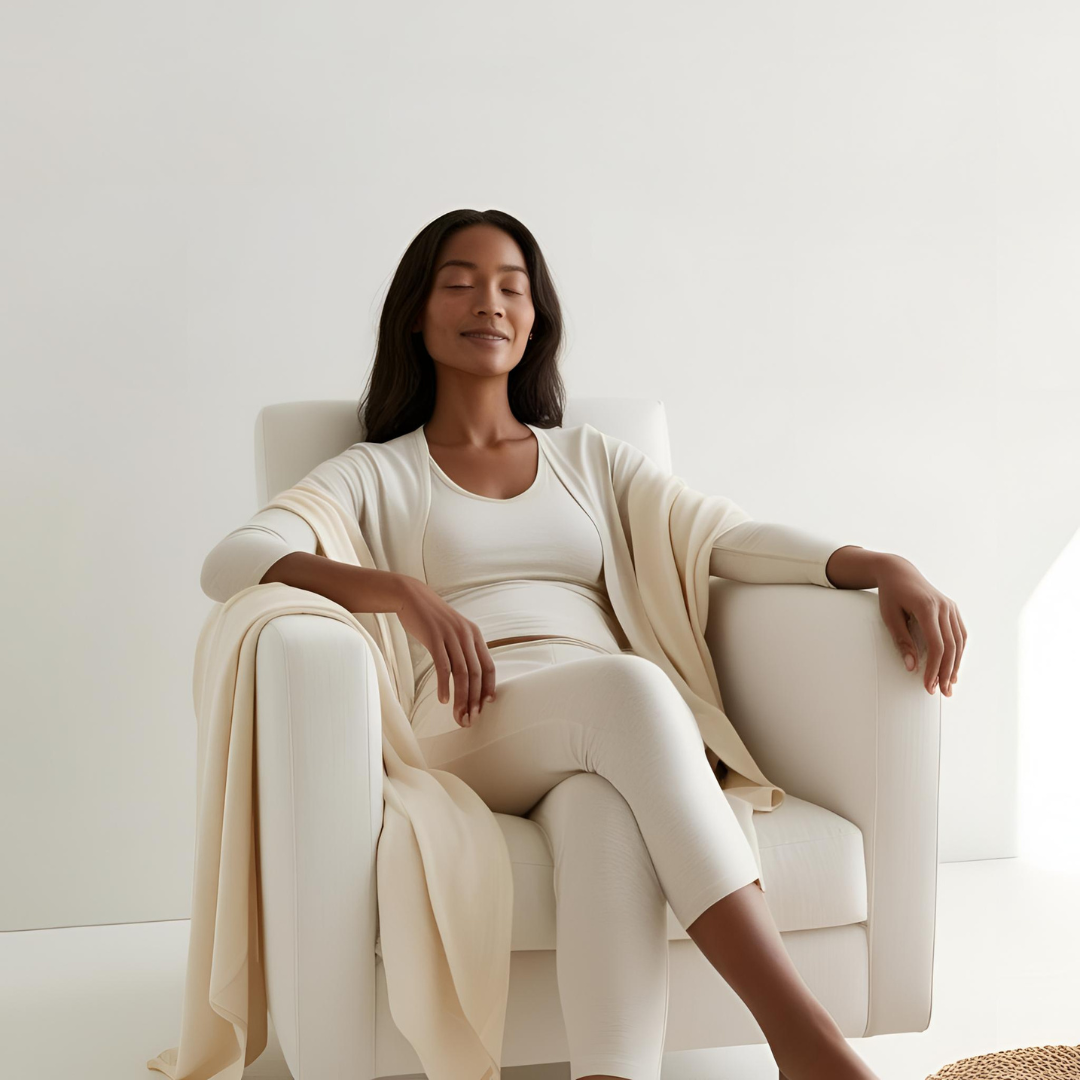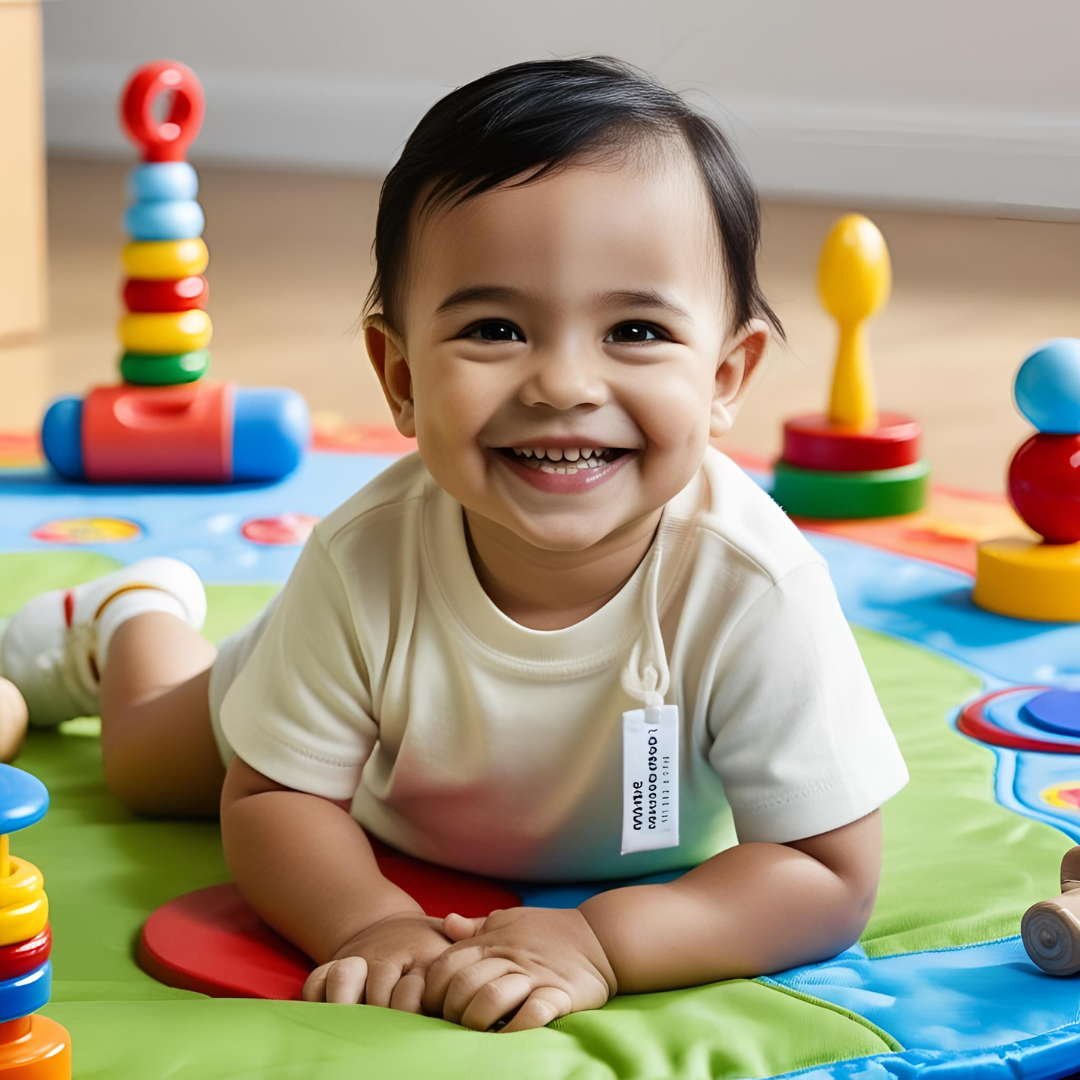Adapted children’s fashion has gained increasing attention, especially when it comes to meeting the specific needs of children with autism. Clothing can have a significant impact on a child with autism’s well-being and daily routine, as they often experience heightened sensory sensitivity. For these children, choosing the right clothes can contribute to their comfort, self-esteem, and development, while making their daily lives more practical and enjoyable. In this article, we will explore what parents of autistic children need to know about adapted fashion, focusing on essential features like Velcro, soft fabrics, and the absence of internal seams. We will also discuss how these adaptations can transform the dressing experience and how to ensure that clothes meet the sensory needs of the child. Why Is Adapted Fashion Important for Autistic Children? Children with autism often experience sensory processing differences, meaning that certain stimuli, such as seams, labels, rough fabrics, or even the sensation of certain types of clothing, can be uncomfortable or even painful. This discomfort can cause distraction, anxiety, and even meltdowns. For these children, wearing “normal” clothes can be a real daily challenge. Adapted fashion comes as a support and accommodation tool. When someone feels physically comfortable, they can focus on other activities—such as studying, working, or socializing. In other words, it directly impacts the quality of life and self-esteem of children. Additionally, this approach is also valuable for children, the elderly, and people with reduced mobility, as it provides independence by making dressing and undressing easier. Even those without any clinical condition can benefit from the lightness, practicality, and well-being that sensory clothing offers. Features of Adapted Fashion for Autistic Children 1. Velcro Instead of Buttons and Zippers Traditional fasteners, such as buttons and zippers, can be difficult to handle and uncomfortable for many autistic children. Velcro, on the other hand, is a practical and comfortable solution. It allows children to dress themselves more easily, providing independence. Furthermore, Velcro eliminates discomfort caused by the pressure of buttons and zippers against the skin, as it is soft and adjustable. Clothes with Velcro are also ideal for children who have fine motor difficulties or coordination challenges, as Velcro is simple to manage and adjust. 2. Soft and Comfortable Fabrics Another essential aspect of adapted children’s fashion is fabric choice. Autistic children often have sensitive skin and can be bothered by rough or synthetic fabrics. Therefore, it is crucial to opt for natural, soft, and breathable materials, such as organic cotton, bamboo, or modal. These fabrics are pleasant to the touch and provide comfort without causing irritation. In addition, natural fabrics help regulate body temperature, preventing excessive heat or sweating, which is particularly important for autistic children who have difficulty with temperature regulation. 3. Absence of Internal Seams Internal seams are another factor that can be uncomfortable for many children with autism. They can cause constant friction against the skin and lead to irritation. Seamless clothing or garments with external seams are an excellent choice for these children, as they reduce the risk of discomfort. Brands that produce adapted fashion for children often use invisible seams or external seams to prevent children from feeling any friction while wearing the clothes. This can significantly improve the dressing experience and increase the acceptance of clothing by the child. 4. Easy-to-Wear and Remove Clothing Practicality is another essential point when it comes to adapted children’s fashion. Clothes with simple fasteners, like Velcro, and designs that require minimal adjustments are perfect for encouraging independence and making dressing easier. Furthermore, clothes with elastic waistbands or looser fits allow for more freedom of movement, which is important for children who struggle with tight or restrictive clothing. How to Choose the Right Clothes for Your Autistic Child Now that you know some of the key features of adapted children’s fashion, it’s important to understand how to choose the right clothing for your child. Here are some tips: 1. Look for Visible or Removable Labels Clothing labels are one of the biggest sources of discomfort for many autistic children. Look for clothes with visible or, preferably, removable labels. Brands that produce adapted fashion often print the information directly on the fabric, eliminating the need for internal labels. 2. Try Different Styles and Fabrics Every child has their own preferences when it comes to comfort. Therefore, it’s important to try different types of fabrics and clothing styles until you find those that your child enjoys. Clothes with looser cuts, soft fabrics, and that don’t irritate the skin are usually the most suitable. 3. Choose Clothes that Promote Independence If your child is at a stage where they can start dressing themselves, look for clothes that make this process easier. Clothes with Velcro, elastic waistbands, and easy-to-manage fasteners are perfect for encouraging your child’s independence. 4. Consider Your Child’s Sensory Preferences In addition to the clothes themselves, it’s essential to consider your child’s sensory preferences. Some children may prefer tighter clothes (like form-fitting t-shirts), while others may feel more comfortable with looser pieces. Pay attention to how your child reacts to clothes to make choices that meet their sensory needs. Adapted children’s fashion has the power to transform the daily lives of autistic children by providing comfort, practicality, and independence. By choosing clothes with features like Velcro, soft fabrics, and the absence of internal seams, parents can ensure their children feel comfortable and confident in their clothing. Adapted fashion not only makes daily life easier but also contributes to a child’s self-esteem and promotes a more inclusive and welcoming environment.
Fashion for All Bodies, Minds, and Needs: Campaigns with Neurodivergent Models and Real Representation
Fashion has evolved significantly in recent years, moving towards greater inclusivity and representation of diverse body types, identities, and abilities. The fashion industry is beginning to embrace the idea that style is not confined to a specific mold but should be accessible to everyone—regardless of body shape, neurodiversity, or other unique needs. One of the most important movements within this shift is the inclusion of neurodivergent models in campaigns, which brings real representation to the forefront and sends a powerful message about acceptance and diversity. This article explores the impact of campaigns featuring neurodivergent models, the significance of real representation, and how fashion can embrace the diversity of bodies, minds, and needs to create a more inclusive world for all. Why Neurodivergent Representation Matters in Fashion The term neurodivergent refers to individuals whose neurological development and functioning are atypical, including people with conditions such as autism, ADHD, dyslexia, and other cognitive or developmental variations. For many years, the fashion industry has primarily focused on models who fit a narrow standard of beauty, excluding those with neurodivergent traits and physical differences. However, increasing representation is crucial because: Campaigns Featuring Neurodivergent Models: Paving the Way for Inclusivity Several brands and fashion campaigns have already begun to make strides toward greater inclusivity by showcasing neurodivergent models. These initiatives are not only a step toward diversity but also offer a more accurate reflection of society at large. Here are some campaigns that have made an impact: 1. Tommy Hilfiger’s “Tommy Adaptive” Campaign Tommy Hilfiger’s adaptive line, “Tommy Adaptive,” is designed for individuals with disabilities, including those who are neurodivergent. The brand has featured neurodivergent models in their advertising, and the clothing line includes thoughtful designs such as sensory-friendly fabrics, easy closures, and adjustable fits. The campaign emphasizes the importance of inclusivity, with models of various abilities, including neurodivergent individuals, proudly wearing the adaptive collection. Impact: The campaign brought attention to the fact that fashion can be functional without sacrificing style. It also highlighted how clothing can be accessible, allowing individuals to feel confident and comfortable in their outfits. 2. ASOS’s “ASOS Design Inclusive” Campaign ASOS has been at the forefront of body and mind inclusivity, featuring models of various body shapes, ethnicities, and neurotypes. Their “ASOS Design Inclusive” campaign focused on inclusive designs that accommodate different needs, including options for people with sensory sensitivities. ASOS has worked with neurodivergent models to show that fashion should reflect the diversity of its audience. Impact: This campaign gave visibility to neurodivergent individuals in a mainstream fashion context, showing that people of all minds deserve to be represented. It also helped raise awareness of the importance of both comfort and style in fashion. 3. H&M’s “H&M for All” Campaign H&M’s “H&M for All” campaign is another example of a major brand embracing inclusivity. The campaign includes neurodivergent models as part of its diverse representation of people with various abilities and needs. It highlights the brand’s commitment to inclusivity, demonstrating that every person, regardless of neurological differences, should feel comfortable and confident in their clothing. Impact: By featuring neurodivergent models, H&M has challenged traditional beauty standards in fashion and made an important statement about accessibility and inclusion. Real Representation: Beyond the Runway While featuring neurodivergent models in campaigns is a step in the right direction, true representation goes beyond just a few advertising photoshoots. It’s about creating a fashion culture that embraces all bodies, minds, and needs, ensuring that neurodivergent individuals have the opportunity to: The Future of Inclusive Fashion for All Bodies, Minds, and Needs The shift toward inclusive fashion is ongoing, and the future holds even more promise. To continue making progress, brands should: Conclusion: The Power of Real Representation Fashion for all bodies, minds, and needs is about more than just clothing—it’s about creating a world where everyone feels seen, valued, and included. Neurodivergent models and campaigns are leading the charge in promoting inclusivity and ensuring that people of all neurological backgrounds have access to fashion that celebrates their uniqueness. By continuing to embrace diversity and representat
Inclusive Lookbook: How to Create Stylish and Sensory-Friendly Outfits at the Same Time
Creating a stylish yet sensory-friendly lookbook can be an exciting way to showcase inclusive fashion that is both fashionable and comfortable for people with sensory sensitivities. Whether you’re creating outfits for individuals on the autism spectrum, those with sensory processing disorder (SPD), or anyone looking for more comfortable clothing options, it’s important to blend style and sensory comfort seamlessly. Below are tips on how to build outfits that look great and feel even better, along with suggestions for photo sessions or short video clips to highlight your creations. Why Create an Inclusive Lookbook? An inclusive lookbook goes beyond just showcasing trendy clothes—it highlights the importance of considering comfort and accessibility in fashion. For many individuals with sensory sensitivities, typical clothing can be uncomfortable due to: By adapting your wardrobe to suit sensory needs, you help make fashion more accessible to everyone. This lookbook serves as a guide to building stylish, functional outfits that don’t compromise comfort. Key Features of Sensory-Friendly Outfits When assembling outfits for an inclusive lookbook, keep in mind these important features of sensory-friendly clothing: Creating Stylish and Comfortable Outfits When creating your inclusive outfits, aim for a balance between comfort and style. Here are some tips to build fashionable looks that are also sensory-friendly: 1. Casual Cool: Soft Cotton Tee + Loose-Fitting Pants Lookbook tip: Capture a laid-back vibe with a short video showing someone relaxing in the outfit while reading a book or sipping coffee, highlighting both the comfort and ease of movement. 2. Relaxed Yet Chic: Flowing Dress with Hidden Seams Lookbook tip: Feature a photoshoot in a natural setting, like a park or garden, with a focus on movement and ease. Film a short video of someone spinning or walking to highlight how the dress moves comfortably. 3. Comfortable Layers: Oversized Sweater + Soft Leggings Lookbook tip: In a short video, showcase how easy it is to slip into this outfit while transitioning between indoor and outdoor activities, emphasizing the versatility of the pieces. 4. Functional Elegance: Sensory-Friendly Jumpsuit Lookbook tip: Capture a professional yet relaxed look with a photoshoot in an urban or cozy setting, showing how the jumpsuit works for both casual and semi-formal occasions. Add a quick video demonstrating the ease of putting on and taking off the jumpsuit. 5. Simple Yet Stylish: Long-Sleeve Top + Soft Skirt Lookbook tip: Use a playful photoshoot to highlight the fluidity of the skirt as someone twirls or enjoys an outdoor activity. Capture both the movement of the skirt and the cozy, comforting feel of the outfit. Showcasing Your Inclusive Lookbook Whether you’re creating a photo gallery or a short video series, the key to showcasing your inclusive outfits is to highlight both their aesthetic appeal and sensory benefits. Here are some ways to effectively present your looks: Creating an inclusive lookbook is not just about showcasing clothing—it’s about telling a story of comfort, accessibility, and style for those with sensory sensitivities. By incorporating soft fabrics, thoughtful designs, and inclusive fashion choices, you can create outfits that are both visually appealing and comfortable to wear. Whether it’s for daily use or special occasions, these sensory-friendly outfits can empower individuals to express themselves confidently, all while feeling their best.
DIY: How to Adapt Regular Clothes to Make Them More Comfortable for Autistic Individuals
When it comes to clothing, many autistic individuals experience heightened sensitivity to certain textures, seams, or labels, making traditional clothing uncomfortable and even distressing. Fortunately, there are simple and effective DIY solutions to adapt regular clothes into sensory-friendly garments. By making a few small adjustments, you can significantly improve comfort and reduce sensory overload for those with autism. This guide will walk you through practical tutorials for adapting everyday clothing items to make them more sensory-friendly, ensuring comfort without compromising on style. Why Adapt Clothes for Autistic Individuals? Autistic individuals often experience sensory processing differences, meaning their brains interpret sensory information differently. Common clothing issues for those on the autism spectrum include: The goal of adapting clothing is to reduce discomfort and avoid sensory overload, allowing individuals to focus on their daily activities without being distracted by what they’re wearing. 1. Removing or Replacing Tags One of the most common complaints from people with sensory sensitivities is the discomfort caused by clothing tags. Whether they’re sewn inside the neck or at the waistband, tags can cause itching, irritation, and frustration. Fortunately, this is an easy fix! How to adapt: 2. Flattening or Removing Seams Seams can cause discomfort if they rub against the skin in sensitive areas. A quick and easy way to make clothes more comfortable is by flattening or removing the seams altogether. How to adapt: 3. Softening the Fabric Fabric texture plays a major role in comfort, especially for people with sensory sensitivities. Rough fabrics like polyester, wool, or synthetic materials can be irritating, whereas softer fabrics like cotton, bamboo, or modal are gentler on the skin. How to adapt: 4. Replacing Tight Waistbands Tight waistbands can cause discomfort and restriction, particularly for those with sensory sensitivities. Instead of opting for a traditional waistband, there are several alternatives that are more comfortable and accommodating. How to adapt: 5. Adding Sensory-Friendly Pockets For some individuals, pockets are an essential part of comfort, but traditional pockets can sometimes be bulky or irritating. Adding or adjusting pockets in clothing can help provide a sensory-friendly solution. How to adapt: 6. Choosing Sensory-Friendly Colors and Patterns While texture is the primary consideration in sensory clothing, color and pattern can also play a role in comfort. Bright, bold patterns can sometimes be overwhelming for individuals with sensory sensitivities, so opting for soft, calming tones is a great idea. How to adapt: 7. Adjusting Fit and Cut Tight or restrictive clothing can be uncomfortable, so ensuring that clothes have a comfortable fit is crucial for sensory-friendly clothing. How to adapt: 8. DIY Sensory-Friendly Accessories Sometimes, adding sensory-friendly accessories can make a huge difference in overall comfort. How to adapt: Making clothing more comfortable for individuals with autism is about understanding their unique sensory needs and making simple, thoughtful changes. By following these DIY tips and tutorials, you can transform regular clothes into sensory-friendly garments that promote comfort and reduce sensory overload. Whether it’s removing tags, softening fabrics, or adjusting fit, these small changes can make a world of difference in the lives of individuals with autism.
Developing a Sensory Clothing Line: Behind the Creation Process
Creating a sensory clothing line is not just about designing stylish garments—it’s about making clothes that offer comfort, inclusion, and relief to people with sensory sensitivities. Whether you’re a designer looking to dive into inclusive fashion or someone simply curious about the process, understanding the steps involved in developing a sensory clothing line is key. Sensory-friendly clothing is designed with people who experience heightened sensitivities in mind, such as those with autism, ADHD, sensory processing disorder (SPD), fibromyalgia, or chronic pain conditions. These clothes address common discomforts such as itchy fabrics, tight seams, or uncomfortable tags, providing relief and allowing individuals to go about their day without the constant stress of dealing with physical irritants. Let’s dive into the key steps for developing a sensory clothing line and what goes on behind the scenes when creating these garments that cater to sensory needs. Step 1: Understanding the Needs of the Neurodivergent Community Before you even sketch the first design, it’s crucial to deeply understand the sensory needs of the people you’re designing for. This means getting firsthand insights into what works and what doesn’t from people who live with conditions like autism, ADHD, or sensory processing disorder. How to start? By listening to and learning from those who experience sensory sensitivities, you can gain an understanding of what makes clothing both comfortable and accessible. This empathy-driven approach ensures that your designs align with the needs of your audience. Step 2: Fabric Selection – The Foundation of Sensory-Friendly Clothing The fabrics you choose will play a significant role in determining the overall comfort and functionality of your sensory clothing line. Fabrics need to be soft, breathable, and non-irritating, which is crucial for individuals with heightened sensitivity to touch. Ideal fabric options for sensory clothing: Avoid fabrics that may cause discomfort, such as synthetics, polyester, and rough textures that can lead to itching or overheating. Step 3: Seamless and Soft Designs One of the biggest challenges for people with sensory sensitivities is irritation from seams and tags. To address this, many sensory clothing lines incorporate seamless designs, which eliminate any discomfort caused by stitching. Key design elements: Step 4: Colors and Prints – Calming and Soothing Choices While fabric and design are crucial, the colors and prints used in sensory-friendly clothing should also be considered. Bright, bold patterns can be overwhelming for individuals who experience sensory overload, so the color palette should focus on soothing tones and simple designs. Ideal color palette: By focusing on calming colors and minimalist patterns, you can create clothing that promotes peace and comfort. Step 5: Prototyping and Testing Once the fabrics, designs, and details are selected, it’s time to create prototypes. But before launching your line to the public, it’s essential to test these garments with the very people they are designed to help. This will allow you to see how the clothing performs in real-life situations and gather valuable feedback. Key steps in testing: This iterative process ensures that the final product is truly sensory-friendly and meets the needs of your target audience. Step 6: Production and Ethical Considerations Once you’ve finalized the design, it’s time for production. Ethical production is particularly important in inclusive fashion. Look for sustainable practices, eco-friendly materials, and fair labor standards to ensure that your clothing line is aligned with your values. Things to consider during production: By choosing ethical production methods, you not only create a better product but also contribute to a more sustainable and responsible fashion industry. Step 7: Marketing and Raising Awareness When marketing your sensory clothing line, it’s important to emphasize the benefits of the designs and fabrics, as well as the impact they have on the well-being of neurodivergent individuals. Highlight real stories from customers who have found relief and comfort in your products. Marketing tips: By educating your audience and making your message clear, you can attract customers who understand the importance of your work and who are eager to support your inclusive clothing line. Developing a sensory clothing line is an incredibly rewarding process that requires empathy, creativity, and attention to detail. By designing clothes that prioritize comfort, accessibility, and inclusivity, you can make a real difference in the lives of neurodivergent individuals and contribute to a more inclusive fashion industry. Whether you’re an experienced fashion designer or someone just starting in the world of inclusive fashion, the creation of sensory-friendly clothing offers a unique opportunity to create something that goes beyond style—it can be life-changing for many people. So, dive in, listen to your audience, and make a lasting impact with your designs.
Interview with Neurodivergents About Their Clothing Preferences
Inclusive fashion goes beyond trends and comfort – it’s about giving a voice to those living with neurodivergent conditions such as autism, ADHD, and other sensory differences. There’s no better way to understand their preferences, challenges, and needs regarding clothing than by listening directly to those who experience it every day. In this interview, we speak with three neurodivergent individuals about their personal experiences and how clothing can impact their well-being. Their stories serve as a powerful reminder that fashion should be accessible, comfortable, and, above all, empathetic. Interview with Ana, 34, Diagnosed with Autism How does clothing affect your well-being day-to-day? Ana: “I feel that my choice of clothes can really affect my mood. If I’m wearing something uncomfortable, like seams or labels inside the garment, I get really agitated and it affects my focus. I have a higher sensitivity to textures, so when the clothes are uncomfortable, it feels like I can’t concentrate on anything else.” What features do you look for in clothing that really help you feel comfortable? Ana: “I avoid clothes with internal labels because they really bother me. I prefer soft fabrics like organic cotton and don’t like clothes that are too tight, like jeans or pieces with thick seams. Clothes with Velcro or magnetic zippers also help me a lot because I can dress more easily. For me, it’s about feeling like I can move freely without anything constricting me.” Interview with Lucas, 27, Diagnosed with ADHD How does ADHD influence your clothing choices? Lucas: “I’m someone who changes moods quickly, so uncomfortable clothes can really affect my day. I often can’t focus on tasks because the discomfort from the clothes distracts me. I also notice that my ADHD makes me more impulsive, so I need clothes that are practical and quick to put on without much fuss. Clothes with buttons or complicated zippers are not for me!” What do you consider important when choosing clothes? Lucas: “Clothes with elastic bands and no thick seams are ideal for me. I look for pieces that don’t restrict me or require too much effort to wear. I prefer fabrics that are lightweight, breathable, and don’t make me sweaty, like bamboo or modal. If the garment has quick adjustments, like Velcro or magnetic buttons, even better! I like practicality because it helps reduce frustration.” Interview with Sofia, 40, Diagnosed with Asperger Syndrome What challenges do you face when choosing clothing? Sofia: “I think one of the biggest challenges for me is finding clothes that feel ‘right’. I often experience sensory overload with synthetic fabrics, and even the seams can become uncomfortable to the point where I just want to take the clothes off. Also, my movement patterns are different, so often popular clothing doesn’t work for me.” What are the essential qualities of clothing you look for? Sofia: “The fabric quality is the most important. I avoid synthetic fabrics because they irritate me. I look for cotton, linen, or any other natural fabric that’s soft and doesn’t cause friction. Clothes need to be gentle and comfortable. I also prefer simpler styles with minimal embellishments. I don’t like things that restrict or make movement difficult.” Final Thoughts: Listening to Neurodivergents is Crucial The interviews with Ana, Lucas, and Sofia show that the clothing needs of neurodivergent individuals should not be seen as secondary or merely an aesthetic issue. For many people, discomfort with clothing can have a profound impact on their quality of life, affecting everything from productivity to emotional well-being. Listening to and understanding these preferences is the first step towards evolving the fashion industry in an inclusive way. By giving a voice to those who live with these realities, we are creating a future where fashion respects, embraces, and promotes the autonomy of all. These experiences also show us that inclusive fashion should be built with empathy, addressing the sensory and functional needs of each individual. Only then can we create a more equal and conscious environment where everyone feels comfortable and confident in what they wear.
Brands That Are Transforming Inclusive Fashion for Autism (ASD)
Inclusive fashion is steadily gaining ground in the market—especially when it comes to people on the autism spectrum (ASD). For this group, who may experience sensory hypersensitivity, motor difficulties, or strong preferences for routine, choosing clothing is not just about style—it’s a functional need. Fortunately, some brands are listening closely to these needs and designing pieces that go far beyond appearance. They create clothing that comforts, respects, and helps build the wearer’s confidence. Below is a curated list of companies that are truly revolutionizing inclusive fashion with thoughtful and transformative ideas. 1. Friendly Shoes – Functional Footwear with Inclusive Design Let’s start from the ground up. Putting on shoes can be a huge challenge for individuals with autism and motor coordination difficulties. American brand Friendly Shoes has developed footwear with wide zippers on the sides or front, allowing the shoe to open completely for easy foot insertion. These designs are perfect for both children and adults with ASD, as they eliminate the frustration of laces. Plus, they feature non-slip soles, comfortable insoles, and stylish looks—blending function with fashion. 2. Boden Adaptive – Sensory-Friendly Kids’ Clothing British brand Boden, known for colorful, playful prints, launched the Boden Adaptive line for neurodivergent children. Every piece is developed with input from parents, caregivers, and occupational therapists, making the designs truly responsive to real needs. Their clothes feature printed or external tags, soft fabrics like organic cotton, magnetic zippers, and loose-fitting cuts that won’t constrict. They also promote independence by making it easier for kids to dress themselves. 3. NoNetz – Seam-Free Swimwear That Doesn’t Irritate Going to the beach or pool can be tough for individuals with autism, as swimwear often includes rough seams, scratchy tags, or irritating linings. NoNetz solves this issue with sensory-friendly swimwear—no internal tags, no abrasive seams, and breathable, antimicrobial fabrics. Their swim trunks and suits are designed to prevent sensory meltdowns and make aquatic fun accessible and enjoyable. 4. Billy Footwear – Shoes That Open Completely With an innovative “U-shaped” zipper system, Billy Footwear creates shoes that fully open across the top, making it simple to slide the foot in without resistance. These shoes are a favorite among families of children with ASD due to their focus on independence, comfort, and cool, inclusive design available in a range of colors and sizes. 5. Zappos Adaptive – A Marketplace for Accessible Clothing Retail giant Zappos has carved out a special section called Zappos Adaptive, curating products that include sensory-friendly clothing, easy-on shoes, tagless items, and more. What sets them apart is how they actively listen to their customers. With feedback forms, user testing, and real-life model photos, they offer a shopping experience built on empathy and real-life application. 6. H&M Kids Adaptive Line – Fast Fashion with a Conscience H&M is one of the few global fast fashion brands investing in adaptive children’s wear. Their adaptive line includes pieces with magnetic closures, tagless labels, elastic waistbands, and breathable fabrics—plus all the fun, trendy styles kids love. They’ve also featured real children in marketing campaigns, promoting representation and awareness of neurodiversity in mainstream fashion. 7. Tommy Hilfiger Adaptive – Timeless Style with Smart Adjustments Tommy Adaptive by Tommy Hilfiger is perhaps the most high-end label to make a serious commitment to inclusive design. Their pieces offer smart adaptations—Velcro closures, magnetic buttons, side openings—discreetly woven into polished and elegant garments. These clothes are especially appreciated by teens and adults with ASD who want to look stylish while maintaining comfort and ease of wear. 8. EZ Socks – Me-Time-Friendly and Sensory-Safe Socks can be surprisingly difficult for kids with autism—tight bands, twisted seams, and bunching can trigger sensory discomfort. EZ Socks offers a brilliant solution: soft, seamless socks with handy pull-up loops on both sides. These fun, kid-friendly socks are therapist-recommended and help children gain independence with daily dressing. What Do These Brands Have in Common? Every brand on this list shares one critical trait: they listen. Instead of guessing what people need, they engage in direct dialogue with autistic individuals, families, caregivers, and health professionals. The result is apparel that respects the body, behavior, and sensory profile of each person. These aren’t just adapted clothes—they’re adapted experiences. Inclusive fashion isn’t about “doing charity.” It’s about offering dignity, functionality, and beauty to every kind of body. And when brands take that mission seriously, real change happens.
Clothes That Hug: Soothing Fabrics and Cuts for Everyday Comfort
In today’s fast-paced world, finding comfort and well-being in small daily choices has become essential. One of those choices is closer than you might think: the clothes we wear. When crafted with the right materials and thoughtful design, fashion can literally embrace the body—and the mind. The growing demand for calming fabrics, gentle cuts, and clothes that respect body sensitivity reflects an important shift: dressing is no longer just about style—it’s also about personal care and emotional balance. Why Do Some Clothes Feel Calming? Our bodies are covered in nerve endings and touch sensors. Stimuli such as heat, friction, or rough textures can easily trigger discomfort—especially in individuals with sensitive skin, fibromyalgia, autism, or ADHD. But even people without such conditions can feel the effects of stiff fabrics or badly placed seams. So when we talk about “clothes that hug,” we mean garments that provide lightness, a soft touch, freedom from irritation, and a sense of emotional safety. They help the body relax, encourage deeper breathing, and can even uplift your mood. The Power of Organic Cotton Among all natural fabrics, organic cotton stands out as one of the most comforting. Grown without pesticides and processed with eco-friendly methods, it preserves the natural softness of the fiber and avoids chemical treatments that can irritate the skin. Clothing made with organic cotton is soft, breathable, and thermally balanced. That means it keeps you cool in the heat and warm in the cold—without causing excess sweat or itchiness. Perfect for sleeping, relaxing, yoga, or simply getting through the day in peace. Bamboo: Softness Meets Sustainability Another fabric gaining recognition for its calming properties is bamboo. Naturally hypoallergenic and antibacterial, bamboo fabric has an even smoother texture than cotton. Plus, bamboo grows quickly and uses little water, making it an eco-conscious choice. Bamboo clothing is ideal for people with eczema, allergies, or sensitive skin. Its silky feel helps reduce itching and inflammation while creating a cooling, soothing effect. T-shirts, pajamas, and underwear made from bamboo are like a gentle hug for your skin. Tagless Fabrics: Small Details, Big Relief Have you ever bought a beautiful piece of clothing only to find it unbearable because of an itchy tag? This is one of the most common triggers of discomfort—especially for children, autistic individuals, or those with tactile hypersensitivity. The solution lies in tag-free clothing. Some brands print size and care info directly onto the fabric or use removable stickers. This simple adjustment eliminates friction with the skin and makes wearing clothes a much more peaceful experience. Gentle Seams and Ergonomic Cuts Seams are another critical factor in calming clothing. Thick seams in high-contact areas like the shoulders or waistband can be distracting or irritating throughout the day. Flat seams, reversed seams, or seamless designs offer maximum comfort. Cut and shape matter too. Loosely tailored, ergonomic fits made with stretchy materials allow clothes to move with your body. This creates a sense of constant, comfortable pressure—almost like a soft, lasting hug. Light Compression: A Gentle Embrace Some clothing offers a touch of compression—mild, targeted, and carefully designed. This is especially helpful for people who feel more secure when gently “held” by their clothes. Think of shirts, vests, and leggings that offer support without being tight. This gentle compression can activate the parasympathetic nervous system, which triggers a relaxation response. The result is improved focus, lower anxiety, and a general sense of calm. It’s a technique used often in sensory therapy for neurodivergent children. Dressing as an Act of Self-Care Choosing clothes with calming fabrics is an act of kindness toward yourself. In a world that demands constant performance, wearing something that brings peace can be a quiet invitation to slow down and breathe. Even in formal or professional settings, you can incorporate calming clothing: a soft cotton shirt under your blazer, seamless undergarments, or garments made from natural fibers—all of these contribute to daily comfort and emotional well-being. Calming Clothes for Every Age This type of clothing can benefit: Fashion as a Way to Feel We are entering a new era of fashion—one where what we wear is not just about what others see, but how we feel. Natural fabrics, gentle cuts, calming colors, and mindful design offer more than comfort—they offer empathy, care, and presence. Adopting clothes that hug is a way of valuing your body and your relationship with the world. It’s a simple choice, but one with profound impact on your routine, sleep, productivity, and—most importantly—your emotional state.
Sensory Fashion: The New Frontier of Style and Comfort
Fashion is constantly evolving. What used to be purely about aesthetics is now also focused on accessibility, functionality, and well-being. And that’s where sensory fashion comes in — an inclusive and innovative approach that transforms how people experience clothing. More than just a trend, sensory fashion represents a quiet revolution, especially for individuals with sensory hypersensitivity, autism, ADHD, fibromyalgia, or any condition that causes discomfort with certain physical stimuli. But it also offers practical benefits for anyone seeking greater comfort in everyday life. What is sensory fashion? Sensory fashion is a style of clothing and accessory design created to respect and accommodate the sensory needs of the wearer. That means paying attention to elements like: It aims to eliminate discomforts that often go unnoticed by traditional fashion but can cause serious distress for those with heightened sensitivity. That’s why it’s especially relevant in the world of inclusion, neurodiversity, and conscious fashion. Why is sensory fashion so important? People with autism, for instance, often experience the world differently on a sensory level. An internal label or thick seam can trigger real anxiety, affecting their concentration, mood, and even social interactions. For them, wearing “regular” clothes can be a daily challenge. Sensory fashion serves as a tool for support and comfort. When someone feels physically at ease, they can focus their energy on other activities — learning, working, socializing. In other words, it directly impacts quality of life and self-esteem. This approach also proves valuable for children, the elderly, and people with limited mobility, offering independence by making dressing and undressing easier. Even those without medical conditions can benefit from the softness, practicality, and well-being these garments provide. Everyday examples of sensory fashion 1. Clothes with external or removable tags Many sensory discomforts stem from internal labels. Sensory-conscious brands place tags on the outside, print them directly on the fabric, or use removable stickers. This simple switch eliminates constant skin irritation. 2. Seamless or reversed-seam garments For those who find seams irritating, seamless designs or reversed seams are a game-changer. This style is commonly found in t-shirts, leggings, socks, and underwear. 3. Soft, breathable fabrics Fabrics like organic cotton, modal, and viscose are lighter, softer, and allow the skin to breathe. They don’t trap heat or cause irritation like rough or synthetic materials do. 4. Shoes with orthopedic insoles and no laces For people with motor difficulties or foot sensitivity, sensory-friendly shoes offer features like non-slip soles, velcro closures, and ergonomic shapes — eliminating the struggle of tying shoelaces. 5. Light compression clothing Some individuals feel more secure when clothing gently “hugs” their body. Sensory fashion includes light compression in select areas to provide that feeling without restricting circulation. It’s often used in shirts, vests, and clothing for neurodivergent children. 6. Soothing colors and patterns Although sensory fashion prioritizes touch, visual elements also matter. Soft colors, pastel tones, and minimalist prints help avoid visual overstimulation. How to choose sensory-friendly clothing in practice Even if you don’t live near a specialized store, you can adapt your shopping habits to align with sensory fashion principles: If you’re shopping online, read customer reviews. Many retailers now label items as sensory-friendly or adaptive, making it easier to find suitable options. Sensory fashion for children: essential support In childhood, sensory sensitivity can be even more intense. Children with ASD, for example, often reject school uniforms or formal wear due to discomfort. In these cases, adopting sensory fashion can prevent meltdowns and support daily routines. Garments like t-shirts with hidden side zippers, pants without buttons or belts, and even magnetic closures can make a big difference in comfort and independence. Sensory fashion and sustainability: a perfect match A lesser-known but highly relevant aspect of sensory fashion is its environmental impact. Because these pieces are usually made from natural, durable materials and designed to last, they often align with the values of sustainable fashion. Production also tends to be more ethical, valuing the labor of seamstresses and small workshops. So by investing in sensory fashion, consumers are also supporting a more fair and conscious production chain. How sensory fashion can transform lives More than just clothes, sensory fashion offers freedom. It stands for the right to feel good in what you wear without sacrificing style, practicality, or self-confidence. As more brands embrace sensory diversity, we’re moving toward a truly inclusive fashion future — where comfort and identity walk hand in hand. The good news is, this transformation is already happening and available for anyone open to trying it. Whether it’s for an autistic child, a woman with fibromyalgia, or an adult simply seeking more comfort, sensory fashion is an invitation to dress with empathy and care.
The Symphony of the Boreal Forest: Night Sounds That Tell Stories
Boreal forests, also known as taigas, stretch across vast regions of the Northern Hemisphere and are home to a natural symphony that becomes more intense as night falls. While darkness envelops the tall trees and frozen lakes, a hidden soundscape awakens — subtle, ancient, and deeply revealing. These rare sounds are not only enchanting but also carry scientific, cultural, and spiritual value. When Silence Speaks: The Nocturnal Life of the Boreal Forest At first glance, boreal forests seem silent. But with attention — or a sensitive microphone — one can capture an acoustic richness that escapes the untrained human ear. At night, the environment transforms: wind slides through conifers, owls release their solitary calls, small rodents dig under the snow, and predators like wolves and lynxes move with tense silence. These sounds are more than beautiful — they serve ecological purposes. Territorial calls, danger alerts, mating rituals, or simple nighttime activity form a true acoustic ecosystem. Sounds That Tell Stories Every nocturnal sound in the taiga has something to say. The hoot of the long-eared owl, for instance, echoes among the pines as a signal that the territory is claimed. The subtle cracking of branches can indicate the presence of large animals, such as brown bears foraging for food. The distant howl of a wolf may not only mark location for the pack but also prompt a response from another group miles away. These elements create sound narratives that documentarians, biologists, and even sound therapists are using for various purposes: understanding animal behavior, enhancing audiovisual productions, or inducing meditative states. The Power of Field Recording in the Boreal Forest Capturing these sounds requires skill and patience. Field recorders, parabolic microphones, and windshields are essential tools for those aiming to faithfully document the forest’s nighttime acoustics. In places like Canada, Alaska, Finland, and Russia, famous recordings have been made during long, freezing nights where absolute silence is broken by brief but meaningful sounds. Many of these recordings are now used in documentaries by BBC, National Geographic, and Arte, lending realism and sensory depth to visual content. In addition, sound artists create entire works based on recordings from the boreal wilderness. Applications in Meditation and Relaxation There’s growing interest in using natural sounds to promote relaxation and well-being. Nighttime sounds from boreal forests stand out for their softness and depth. With no human noise, these recordings offer an immersive and grounding experience, useful in practices like mindfulness, yoga, guided meditation, and even sleep aid. The consistency of wind through the trees, the rhythm of nocturnal animals, and the absence of urban noise create a sense of primitive peace, as if the listener were transported to a world untouched by time. A Window into Biodiversity Beyond their artistic and therapeutic value, these sounds are a powerful tool for environmental monitoring. Researchers analyze soundscapes to identify endangered species, track migrations, measure climate change impacts, and assess ecosystem health. In a world where natural habitats are under constant threat, each recording becomes a valuable archive — sometimes the only acoustic record of a little-studied species. Sounds that once went unnoticed are now scientific documents. Invisible Stories Brought to Life What’s most fascinating about the nighttime sounds of boreal forests is how they reveal what the eyes cannot see. A simple scratching noise may indicate an animal marking territory. The rhythm of footsteps in snow reveals size, weight, and even emotional state. In documentaries, these sounds enrich the narrative, creating tension, mystery, or awe — even when the screen is dark. For the audience, listening to the forest means stepping into another dimension of reality. It shows that life continues after the light goes out — that stories are unfolding in silence, and sound is their language. Preserve the Sound to Protect the Future The advance of cities, roads, and industrial exploitation is compromising the natural silence of boreal forests. So-called “noise pollution” is even threatening the communication and survival habits of various species. That’s why recording and preserving the nocturnal sounds of these regions is also an act of environmental conservation. Worldwide initiatives are building sound libraries of natural landscapes before they disappear. Listening to these archives is also a reminder: if we fail to protect the forests, we’ll lose not just biodiversity — but their sonic stories too.

